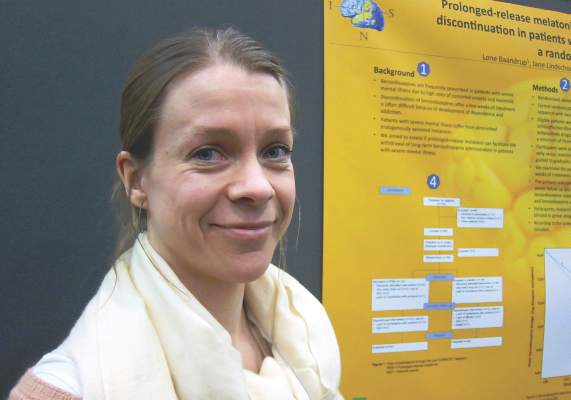User login
Held every two years 15th International Congress on Schizophrenia Research
ICSR: Could a pediatric psychosis screen be on the horizon?
COLORADO SPRINGS – Results from a large, diverse community cohort study of genotyped youth could lead the way to early identification of those most likely to develop psychosis.
Data from the Philadelphia Neurodevelopmental Cohort study are now being analyzed in hopes that patterns emerging from an assessment of 9,421 Philadelphia-area children and young people aged 8-21 years will help researchers identify biomarkers that can be used to identify trajectories of mental illness before the point of clinical diagnosis.
The hope is that this will lead to the creation of a psychosis screening tool, Dr. Raquel E. Gur, one of the lead authors of the study and the Karl and Linda Rickels Professor of Psychiatry at the University of Pennsylvania, Philadelphia, said in an interview at the International Congress on Schizophrenia Research.
Speaking about the difficulties of telling a family that their child is at risk for psychosis, she added: “It’s complex. The parents are often terrified, but it’s a reality. So what can we do to intervene early?” Earlier intervention can lead to better outcomes, she said.
Study participants were recruited from nearly 14,000 previously identified and genotyped children with varying levels of health and a range of medical conditions who were seen at pediatric facilities in Philadelphia and the surrounding region. The mean age of those studied was 14.2 years; 56% were white. Black children and young people represented a third of all study participants, and girls comprised slightly more than half.
In addition to current medical histories, Dr. Gur and her colleagues collected information on participants’ psychiatric and psychological histories using a comprehensive computerized tool to evaluate psychopathology domains such as mood and anxiety disorders. From this, they developed an identification matrix consisting of a strong general psychopathology factor and specific anxious-misery, fear, and behavior factors. They also developed a psychosis spectrum, embedded into the psychopathology screen, that included a general factor and three specific factors: ideas about special abilities/persecution, unusual thoughts/perceptions, and negative/disorganized symptoms. Positive threshold psychotic symptoms such as hallucinations and delusions were assessed with negative/disorganized symptoms typical of the prodromal phase of psychosis.
Dr. Gur said that, because of the absence of data on psychosis in preadolescence, one of their aims was to determine the prevalence of psychotic symptoms – similar to the prodromal symptoms typically displayed in adolescents – in the nearly 5,000 8- to 11-year-olds in the study. The results, she said, were that 3.7% reported psychotic symptoms, while an additional 12.3% reported significant positive subthreshold symptoms such as auditory disturbances and reality confusion. Of those who reported such symptoms, 2.3% reported being distressed by their negative symptoms, in part because they interfered with normal levels of functioning.
“Notably, the young participants were reporting much more than the parents were reporting,” Dr. Gur said. “This pattern shows you need to assess the children directly.”
Severe subthreshold symptoms such as delusions, hallucinations, and auditory disturbances occurred at a level Dr. Gur said was consistent in studies of help-seeking individuals, although more than a third of the study participants had never discussed their distress with anyone.
“Nobody knew what these kids were going through,” she said. “We were the first mental health professionals to know. Not a school nurse, not clergy, nobody. This is a big burden for a young person.”
Even so, she said, these prodromal signs were not appearing in a vacuum. “What we commonly saw was depression, anxiety, difficulty with impulse control, substance use, and suicidal ideation. This is an important clinical period.”
Additional predictive factors for having symptoms of psychosis that Dr. Gur listed included being male and of European descent, cannabis use, reduced global functioning, and being distressed.
Being female had a high association with the anxious-misery factor and low association with the behavior factors.
The assessment’s behavior factor correlated negatively (0.21) with the overall accuracy of neurocognitive performance, particularly in executive and complex reasoning.
If it were possible to determine a child’s chronological age according to a composite score from his neurocognitive performance on the assessment, Dr. Gur said, this might mean it would be possible to determine who would benefit from intervention. Because the study looked for global psychopathologies, Dr. Gur theorized, “maybe all psychopathology is associated with cognitive performance and chronological age. It appears that having a subthreshold psychotic symptom infers vulnerability, so the expectation that somebody who is on the psychotic spectrum at age 16 would perform cognitively like a typically developing teen will not be met. This is something that can be tracked both individually and as a group. It is good clinical data that can be used to appraise child development, like height and weight.”
In the subset of study participants who underwent functional MRI, activation of working memory in the regions of the brain associated with executive function in those positively identified on the psychosis spectrum was lower than in those scored as developing normally (P < .05). Deficits in prefrontal cognitive activity also were noted in the group on the psychosis spectrum when compared with those not on the spectrum (P < .001), although no correlation was found with positive symptom severity. Also in the psychosis-spectrum group, there was elevated activity in the amygdala and other brain regions typically associated with fear, in response to being shown threatening facial expressions (P < .05). The response in the amygdala correlated with positive symptom severity (P = .01) but not with cognitive deficits.
Dr. Gur did not have any relevant disclosures.
On Twitter @whitneymcknight
COLORADO SPRINGS – Results from a large, diverse community cohort study of genotyped youth could lead the way to early identification of those most likely to develop psychosis.
Data from the Philadelphia Neurodevelopmental Cohort study are now being analyzed in hopes that patterns emerging from an assessment of 9,421 Philadelphia-area children and young people aged 8-21 years will help researchers identify biomarkers that can be used to identify trajectories of mental illness before the point of clinical diagnosis.
The hope is that this will lead to the creation of a psychosis screening tool, Dr. Raquel E. Gur, one of the lead authors of the study and the Karl and Linda Rickels Professor of Psychiatry at the University of Pennsylvania, Philadelphia, said in an interview at the International Congress on Schizophrenia Research.
Speaking about the difficulties of telling a family that their child is at risk for psychosis, she added: “It’s complex. The parents are often terrified, but it’s a reality. So what can we do to intervene early?” Earlier intervention can lead to better outcomes, she said.
Study participants were recruited from nearly 14,000 previously identified and genotyped children with varying levels of health and a range of medical conditions who were seen at pediatric facilities in Philadelphia and the surrounding region. The mean age of those studied was 14.2 years; 56% were white. Black children and young people represented a third of all study participants, and girls comprised slightly more than half.
In addition to current medical histories, Dr. Gur and her colleagues collected information on participants’ psychiatric and psychological histories using a comprehensive computerized tool to evaluate psychopathology domains such as mood and anxiety disorders. From this, they developed an identification matrix consisting of a strong general psychopathology factor and specific anxious-misery, fear, and behavior factors. They also developed a psychosis spectrum, embedded into the psychopathology screen, that included a general factor and three specific factors: ideas about special abilities/persecution, unusual thoughts/perceptions, and negative/disorganized symptoms. Positive threshold psychotic symptoms such as hallucinations and delusions were assessed with negative/disorganized symptoms typical of the prodromal phase of psychosis.
Dr. Gur said that, because of the absence of data on psychosis in preadolescence, one of their aims was to determine the prevalence of psychotic symptoms – similar to the prodromal symptoms typically displayed in adolescents – in the nearly 5,000 8- to 11-year-olds in the study. The results, she said, were that 3.7% reported psychotic symptoms, while an additional 12.3% reported significant positive subthreshold symptoms such as auditory disturbances and reality confusion. Of those who reported such symptoms, 2.3% reported being distressed by their negative symptoms, in part because they interfered with normal levels of functioning.
“Notably, the young participants were reporting much more than the parents were reporting,” Dr. Gur said. “This pattern shows you need to assess the children directly.”
Severe subthreshold symptoms such as delusions, hallucinations, and auditory disturbances occurred at a level Dr. Gur said was consistent in studies of help-seeking individuals, although more than a third of the study participants had never discussed their distress with anyone.
“Nobody knew what these kids were going through,” she said. “We were the first mental health professionals to know. Not a school nurse, not clergy, nobody. This is a big burden for a young person.”
Even so, she said, these prodromal signs were not appearing in a vacuum. “What we commonly saw was depression, anxiety, difficulty with impulse control, substance use, and suicidal ideation. This is an important clinical period.”
Additional predictive factors for having symptoms of psychosis that Dr. Gur listed included being male and of European descent, cannabis use, reduced global functioning, and being distressed.
Being female had a high association with the anxious-misery factor and low association with the behavior factors.
The assessment’s behavior factor correlated negatively (0.21) with the overall accuracy of neurocognitive performance, particularly in executive and complex reasoning.
If it were possible to determine a child’s chronological age according to a composite score from his neurocognitive performance on the assessment, Dr. Gur said, this might mean it would be possible to determine who would benefit from intervention. Because the study looked for global psychopathologies, Dr. Gur theorized, “maybe all psychopathology is associated with cognitive performance and chronological age. It appears that having a subthreshold psychotic symptom infers vulnerability, so the expectation that somebody who is on the psychotic spectrum at age 16 would perform cognitively like a typically developing teen will not be met. This is something that can be tracked both individually and as a group. It is good clinical data that can be used to appraise child development, like height and weight.”
In the subset of study participants who underwent functional MRI, activation of working memory in the regions of the brain associated with executive function in those positively identified on the psychosis spectrum was lower than in those scored as developing normally (P < .05). Deficits in prefrontal cognitive activity also were noted in the group on the psychosis spectrum when compared with those not on the spectrum (P < .001), although no correlation was found with positive symptom severity. Also in the psychosis-spectrum group, there was elevated activity in the amygdala and other brain regions typically associated with fear, in response to being shown threatening facial expressions (P < .05). The response in the amygdala correlated with positive symptom severity (P = .01) but not with cognitive deficits.
Dr. Gur did not have any relevant disclosures.
On Twitter @whitneymcknight
COLORADO SPRINGS – Results from a large, diverse community cohort study of genotyped youth could lead the way to early identification of those most likely to develop psychosis.
Data from the Philadelphia Neurodevelopmental Cohort study are now being analyzed in hopes that patterns emerging from an assessment of 9,421 Philadelphia-area children and young people aged 8-21 years will help researchers identify biomarkers that can be used to identify trajectories of mental illness before the point of clinical diagnosis.
The hope is that this will lead to the creation of a psychosis screening tool, Dr. Raquel E. Gur, one of the lead authors of the study and the Karl and Linda Rickels Professor of Psychiatry at the University of Pennsylvania, Philadelphia, said in an interview at the International Congress on Schizophrenia Research.
Speaking about the difficulties of telling a family that their child is at risk for psychosis, she added: “It’s complex. The parents are often terrified, but it’s a reality. So what can we do to intervene early?” Earlier intervention can lead to better outcomes, she said.
Study participants were recruited from nearly 14,000 previously identified and genotyped children with varying levels of health and a range of medical conditions who were seen at pediatric facilities in Philadelphia and the surrounding region. The mean age of those studied was 14.2 years; 56% were white. Black children and young people represented a third of all study participants, and girls comprised slightly more than half.
In addition to current medical histories, Dr. Gur and her colleagues collected information on participants’ psychiatric and psychological histories using a comprehensive computerized tool to evaluate psychopathology domains such as mood and anxiety disorders. From this, they developed an identification matrix consisting of a strong general psychopathology factor and specific anxious-misery, fear, and behavior factors. They also developed a psychosis spectrum, embedded into the psychopathology screen, that included a general factor and three specific factors: ideas about special abilities/persecution, unusual thoughts/perceptions, and negative/disorganized symptoms. Positive threshold psychotic symptoms such as hallucinations and delusions were assessed with negative/disorganized symptoms typical of the prodromal phase of psychosis.
Dr. Gur said that, because of the absence of data on psychosis in preadolescence, one of their aims was to determine the prevalence of psychotic symptoms – similar to the prodromal symptoms typically displayed in adolescents – in the nearly 5,000 8- to 11-year-olds in the study. The results, she said, were that 3.7% reported psychotic symptoms, while an additional 12.3% reported significant positive subthreshold symptoms such as auditory disturbances and reality confusion. Of those who reported such symptoms, 2.3% reported being distressed by their negative symptoms, in part because they interfered with normal levels of functioning.
“Notably, the young participants were reporting much more than the parents were reporting,” Dr. Gur said. “This pattern shows you need to assess the children directly.”
Severe subthreshold symptoms such as delusions, hallucinations, and auditory disturbances occurred at a level Dr. Gur said was consistent in studies of help-seeking individuals, although more than a third of the study participants had never discussed their distress with anyone.
“Nobody knew what these kids were going through,” she said. “We were the first mental health professionals to know. Not a school nurse, not clergy, nobody. This is a big burden for a young person.”
Even so, she said, these prodromal signs were not appearing in a vacuum. “What we commonly saw was depression, anxiety, difficulty with impulse control, substance use, and suicidal ideation. This is an important clinical period.”
Additional predictive factors for having symptoms of psychosis that Dr. Gur listed included being male and of European descent, cannabis use, reduced global functioning, and being distressed.
Being female had a high association with the anxious-misery factor and low association with the behavior factors.
The assessment’s behavior factor correlated negatively (0.21) with the overall accuracy of neurocognitive performance, particularly in executive and complex reasoning.
If it were possible to determine a child’s chronological age according to a composite score from his neurocognitive performance on the assessment, Dr. Gur said, this might mean it would be possible to determine who would benefit from intervention. Because the study looked for global psychopathologies, Dr. Gur theorized, “maybe all psychopathology is associated with cognitive performance and chronological age. It appears that having a subthreshold psychotic symptom infers vulnerability, so the expectation that somebody who is on the psychotic spectrum at age 16 would perform cognitively like a typically developing teen will not be met. This is something that can be tracked both individually and as a group. It is good clinical data that can be used to appraise child development, like height and weight.”
In the subset of study participants who underwent functional MRI, activation of working memory in the regions of the brain associated with executive function in those positively identified on the psychosis spectrum was lower than in those scored as developing normally (P < .05). Deficits in prefrontal cognitive activity also were noted in the group on the psychosis spectrum when compared with those not on the spectrum (P < .001), although no correlation was found with positive symptom severity. Also in the psychosis-spectrum group, there was elevated activity in the amygdala and other brain regions typically associated with fear, in response to being shown threatening facial expressions (P < .05). The response in the amygdala correlated with positive symptom severity (P = .01) but not with cognitive deficits.
Dr. Gur did not have any relevant disclosures.
On Twitter @whitneymcknight
EXPERT ANALYSIS FROM THE ICSR BIENNIAL MEETING
VIDEO – ‘Clear’ link between cannabis use and schizophrenia
COLORADO SPRINGS – Not all people who use cannabis will become psychotic, but for those with just the right constellation of risk factors, cannabis can lead to “chronic schizophrenia,” according to Sir Robin M. Murray, professor of psychiatric research at the Institute of Psychiatry at King’s College London.
And although Dr. Murray says “old-fashioned” cannabis can lead to psychosis, it’s the newer, more potent kinds manufactured in the last decade that pose the greatest risk.
In this interview, recorded at the International Congress on Schizophrenia Research, Dr. Murray discusses the evidence establishing the links between psychosis, schizophrenia, and cannabis, and what clinicians can do to help patients who might be at risk. He warns, however, that not everyone will be able to reverse the damage to the brain that cannabis can cause.
The video associated with this article is no longer available on this site. Please view all of our videos on the MDedge YouTube channel
On Twitter @whitneymcknight
COLORADO SPRINGS – Not all people who use cannabis will become psychotic, but for those with just the right constellation of risk factors, cannabis can lead to “chronic schizophrenia,” according to Sir Robin M. Murray, professor of psychiatric research at the Institute of Psychiatry at King’s College London.
And although Dr. Murray says “old-fashioned” cannabis can lead to psychosis, it’s the newer, more potent kinds manufactured in the last decade that pose the greatest risk.
In this interview, recorded at the International Congress on Schizophrenia Research, Dr. Murray discusses the evidence establishing the links between psychosis, schizophrenia, and cannabis, and what clinicians can do to help patients who might be at risk. He warns, however, that not everyone will be able to reverse the damage to the brain that cannabis can cause.
The video associated with this article is no longer available on this site. Please view all of our videos on the MDedge YouTube channel
On Twitter @whitneymcknight
COLORADO SPRINGS – Not all people who use cannabis will become psychotic, but for those with just the right constellation of risk factors, cannabis can lead to “chronic schizophrenia,” according to Sir Robin M. Murray, professor of psychiatric research at the Institute of Psychiatry at King’s College London.
And although Dr. Murray says “old-fashioned” cannabis can lead to psychosis, it’s the newer, more potent kinds manufactured in the last decade that pose the greatest risk.
In this interview, recorded at the International Congress on Schizophrenia Research, Dr. Murray discusses the evidence establishing the links between psychosis, schizophrenia, and cannabis, and what clinicians can do to help patients who might be at risk. He warns, however, that not everyone will be able to reverse the damage to the brain that cannabis can cause.
The video associated with this article is no longer available on this site. Please view all of our videos on the MDedge YouTube channel
On Twitter @whitneymcknight
AT THE INTERNATIONAL CONGRESS ON SCHIZOPHRENIA RESEARCH
Benzodiazepine reduction without withdrawal symptoms possible in patients with schizophrenia, bipolar disorder
COLORADO SPRINGS – Patients with schizophrenia and bipolar disorder can reduce or even discontinue their reliance on benzodiazepines when kept to a gradually tapered titration, results of a Danish study have shown.
Benzodiazepines often are prescribed to patients with severe mental illnesses to help relieve comorbid anxiety and insomnia. According to Dr. Lone Baandrup, a researcher at the Center for Neuropsychiatric Schizophrenia Research at the Copenhagen University Hospital in Glostrup, Denmark, the treatment is usually meant as a temporary measure during acute episodes, but patients often become addicted.
Dr. Baandrup said in an interview at the biennial meeting of the 15th International Congress on Schizophrenia Research that because it is well established that patients with severe mental illness often suffer from a diminished ability to secrete endogenous melatonin, “we wanted to see if we could facilitate tapering patients off their benzos using a prolonged-release melatonin.”
Dr. Baandrup and her colleagues randomly assigned 86 adults with a diagnosis of schizophrenia, schizoaffective disorder, or bipolar disorder who had been on a daily regimen of an antipsychotic and at least one benzodiazepine derivative for at least 3 months, to receive either prolonged-release melatonin 2 mg daily or matching placebo. In the intention-to-treat analysis, each group was guided by a caregiver to gradually taper their respective daily benzodiazepine dosage.
Participants were examined at baseline and at 8, 16, and 24 weeks, and were monitored weekly by telephone. All participants, researchers, treating clinicians, and outcome assessors were blinded to group assignment.
No significant difference was found between the groups as to mean benzodiazepine dosage at 24 weeks, the study’s primary outcome, but the placebo arm had a greater reduction in benzodiazepine dosage (8.01 mg in the study arm vs. 5.72 mg in placebo; difference between means, –2.29; 95% confidence interval, –5.78-1.21; P = .20).
Nearly half of the placebo group achieved complete cessation of benzodiazepine use, compared with more than one-third of the study group (21 out of 44 vs. 16 out of 42; odds ratio, 0.64; 95% confidence interval, 0.26-1.56; P = .32).
Serious or nonserious adverse events were similar across the groups.
A separate analysis of the data not presented at the conference as to whether melatonin had any effect on subjective sleep measures showed that those in the melatonin group had improved sleep according to the Pittsburgh Sleep Quality Index. When compared with the control group, “the difference was about 2 points, so it was only on the border of clinical significance, but their sleep did not get worse,” Dr. Baandrup said.
The investigators also used the Pittsburgh Sleep Diary to measure whether there were any objective differences in sleep between the melatonin and placebo groups, and found that reducing benzodiazepine use did not result in insomnia. “It remained the same from baseline to follow-up," Dr. Baandrup said. “Many patients are afraid to taper off their benzos because they fear their sleep will worsen, but we didn’t find that.”
Dr. Baandrup did not have any relevant disclosures.
On Twitter @whitneymcknight
COLORADO SPRINGS – Patients with schizophrenia and bipolar disorder can reduce or even discontinue their reliance on benzodiazepines when kept to a gradually tapered titration, results of a Danish study have shown.
Benzodiazepines often are prescribed to patients with severe mental illnesses to help relieve comorbid anxiety and insomnia. According to Dr. Lone Baandrup, a researcher at the Center for Neuropsychiatric Schizophrenia Research at the Copenhagen University Hospital in Glostrup, Denmark, the treatment is usually meant as a temporary measure during acute episodes, but patients often become addicted.
Dr. Baandrup said in an interview at the biennial meeting of the 15th International Congress on Schizophrenia Research that because it is well established that patients with severe mental illness often suffer from a diminished ability to secrete endogenous melatonin, “we wanted to see if we could facilitate tapering patients off their benzos using a prolonged-release melatonin.”
Dr. Baandrup and her colleagues randomly assigned 86 adults with a diagnosis of schizophrenia, schizoaffective disorder, or bipolar disorder who had been on a daily regimen of an antipsychotic and at least one benzodiazepine derivative for at least 3 months, to receive either prolonged-release melatonin 2 mg daily or matching placebo. In the intention-to-treat analysis, each group was guided by a caregiver to gradually taper their respective daily benzodiazepine dosage.
Participants were examined at baseline and at 8, 16, and 24 weeks, and were monitored weekly by telephone. All participants, researchers, treating clinicians, and outcome assessors were blinded to group assignment.
No significant difference was found between the groups as to mean benzodiazepine dosage at 24 weeks, the study’s primary outcome, but the placebo arm had a greater reduction in benzodiazepine dosage (8.01 mg in the study arm vs. 5.72 mg in placebo; difference between means, –2.29; 95% confidence interval, –5.78-1.21; P = .20).
Nearly half of the placebo group achieved complete cessation of benzodiazepine use, compared with more than one-third of the study group (21 out of 44 vs. 16 out of 42; odds ratio, 0.64; 95% confidence interval, 0.26-1.56; P = .32).
Serious or nonserious adverse events were similar across the groups.
A separate analysis of the data not presented at the conference as to whether melatonin had any effect on subjective sleep measures showed that those in the melatonin group had improved sleep according to the Pittsburgh Sleep Quality Index. When compared with the control group, “the difference was about 2 points, so it was only on the border of clinical significance, but their sleep did not get worse,” Dr. Baandrup said.
The investigators also used the Pittsburgh Sleep Diary to measure whether there were any objective differences in sleep between the melatonin and placebo groups, and found that reducing benzodiazepine use did not result in insomnia. “It remained the same from baseline to follow-up," Dr. Baandrup said. “Many patients are afraid to taper off their benzos because they fear their sleep will worsen, but we didn’t find that.”
Dr. Baandrup did not have any relevant disclosures.
On Twitter @whitneymcknight
COLORADO SPRINGS – Patients with schizophrenia and bipolar disorder can reduce or even discontinue their reliance on benzodiazepines when kept to a gradually tapered titration, results of a Danish study have shown.
Benzodiazepines often are prescribed to patients with severe mental illnesses to help relieve comorbid anxiety and insomnia. According to Dr. Lone Baandrup, a researcher at the Center for Neuropsychiatric Schizophrenia Research at the Copenhagen University Hospital in Glostrup, Denmark, the treatment is usually meant as a temporary measure during acute episodes, but patients often become addicted.
Dr. Baandrup said in an interview at the biennial meeting of the 15th International Congress on Schizophrenia Research that because it is well established that patients with severe mental illness often suffer from a diminished ability to secrete endogenous melatonin, “we wanted to see if we could facilitate tapering patients off their benzos using a prolonged-release melatonin.”
Dr. Baandrup and her colleagues randomly assigned 86 adults with a diagnosis of schizophrenia, schizoaffective disorder, or bipolar disorder who had been on a daily regimen of an antipsychotic and at least one benzodiazepine derivative for at least 3 months, to receive either prolonged-release melatonin 2 mg daily or matching placebo. In the intention-to-treat analysis, each group was guided by a caregiver to gradually taper their respective daily benzodiazepine dosage.
Participants were examined at baseline and at 8, 16, and 24 weeks, and were monitored weekly by telephone. All participants, researchers, treating clinicians, and outcome assessors were blinded to group assignment.
No significant difference was found between the groups as to mean benzodiazepine dosage at 24 weeks, the study’s primary outcome, but the placebo arm had a greater reduction in benzodiazepine dosage (8.01 mg in the study arm vs. 5.72 mg in placebo; difference between means, –2.29; 95% confidence interval, –5.78-1.21; P = .20).
Nearly half of the placebo group achieved complete cessation of benzodiazepine use, compared with more than one-third of the study group (21 out of 44 vs. 16 out of 42; odds ratio, 0.64; 95% confidence interval, 0.26-1.56; P = .32).
Serious or nonserious adverse events were similar across the groups.
A separate analysis of the data not presented at the conference as to whether melatonin had any effect on subjective sleep measures showed that those in the melatonin group had improved sleep according to the Pittsburgh Sleep Quality Index. When compared with the control group, “the difference was about 2 points, so it was only on the border of clinical significance, but their sleep did not get worse,” Dr. Baandrup said.
The investigators also used the Pittsburgh Sleep Diary to measure whether there were any objective differences in sleep between the melatonin and placebo groups, and found that reducing benzodiazepine use did not result in insomnia. “It remained the same from baseline to follow-up," Dr. Baandrup said. “Many patients are afraid to taper off their benzos because they fear their sleep will worsen, but we didn’t find that.”
Dr. Baandrup did not have any relevant disclosures.
On Twitter @whitneymcknight
AT THE INTERNATIONAL CONGRESS ON SCHIZOPHRENIA RESEARCH
Key clinical point: Patients with schizophrenia or bipolar disorder can reduce, or even discontinue, reliance on benzodiazepines when tapered gradually but steadily.
Major finding: No significant difference was found in benzodiazepine reduction rates between patients with psychosis given prolonged-release melatonin and placebo.
Data source: Negative, single-center, blinded parallel study of 86 patients with schizophrenia or bipolar disorder randomly assigned to long-acting melatonin or placebo while reducing their benzodiazepine dosage over 6 months.
Disclosures: Dr. Baandrup did not have any relevant disclosures.




